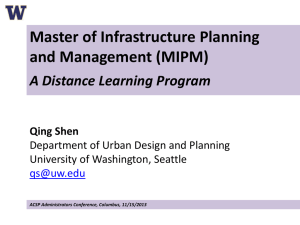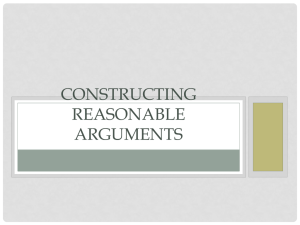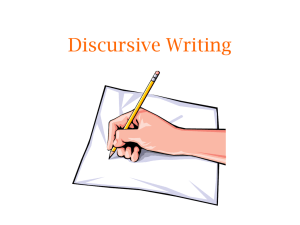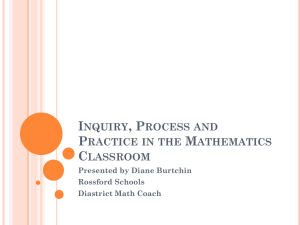writing and reasoning in math
advertisement
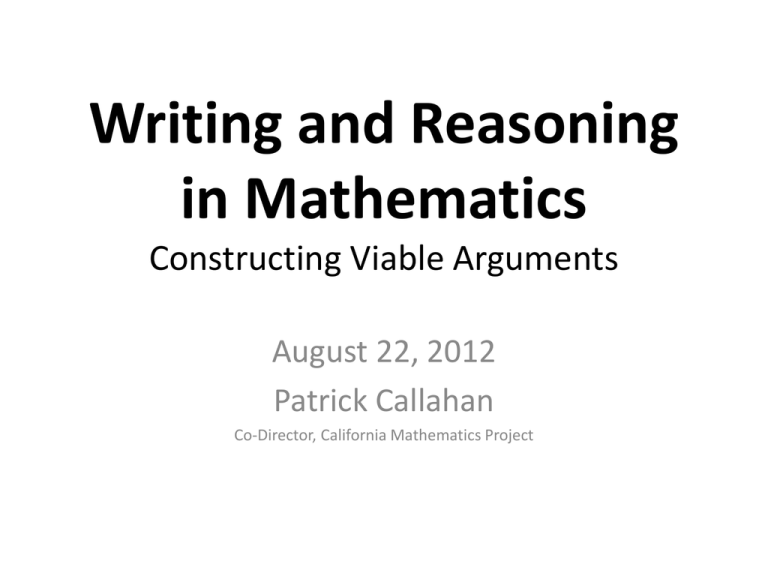
Writing and Reasoning in Mathematics Constructing Viable Arguments August 22, 2012 Patrick Callahan Co-Director, California Mathematics Project As of August 2010, California has new Standards for Mathematics and ELA Mathematical Practice 1. Make sense of problems and persevere in solving them. 2. Reason abstractly and quantitatively. 3. Construct viable arguments and critique the reasoning of others. 4. Model with mathematics. 5. Use appropriate tools strategically. 6. Attend to precision. 7. Look for and make use of structure. 8. Look for and express regularity in repeated reasoning. 1. Make sense of problems and perseveres in solving them 6. Attend to precision OVERARCHING HABITS OF MIND CCSS Mathematical Practices REASONING AND EXPLAINING 2. Reason abstractly and quantitatively 3. Construct viable arguments are critique the reasoning of others MODELING AND USING TOOLS 4. Model with mathematics 5. Use appropriate tools strategically SEEING STRUCTURE AND GENERALIZING 7. Look for and make use of structure 8. Look for and express regularity in repeated reasoning Constructing viable arguments 3 Construct viable arguments and critique the reasoning of others. Mathematically proficient students understand and use stated assumptions, definitions, and previously established results in constructing arguments. They make conjectures and build a logical progression of statements to explore the truth of their conjectures. They are able to analyze situations by breaking them into cases, and can recognize and use counterexamples. They justify their conclusions, communicate them to others, and respond to the arguments of others. They reason inductively about data, making plausible arguments that take into account the context from which the data arose. Mathematically proficient students are also able to compare the effectiveness of two plausible arguments, distinguish correct logic or reasoning from that which is flawed, and—if there is a flaw in an argument—explain what it is. Elementary students can construct arguments using concrete referents such as objects, drawings, diagrams, and actions. Such arguments can make sense and be correct, even though they are not generalized or made formal until later grades. Later, students learn to determine domains to which an argument applies. Students at all grades can listen or read the arguments of others, decide whether they make sense, and ask useful questions to clarify or improve the arguments. Constructing viable arguments • use stated assumptions, definitions, and previously established results in constructing arguments. • make conjectures • build a logical progression of statements • analyze situations by breaking them into cases • recognize and use counterexamples • justify their conclusions, communicate them to others, and respond to the arguments of others • distinguish correct logic or reasoning from that which is flawed Elementary students can construct arguments using concrete referents such as objects, drawings, diagrams, and actions. Such arguments can make sense and be correct, even though they are not generalized or made formal until later grades. Students at all grades can listen or read the arguments of others, decide whether they make sense, and ask useful questions to clarify or improve the arguments. Viable arguments are important beyond mathematics 21st Century Skills Common Core Standards for English Language Arts Career and College Readiness Anchor Standards for Writing Text types and Purposes* 1. Write arguments to support claims in an analysis of substantive topics or texts, using valid reasoning and relevant and sufficient evidence. 2. Write informative/explanatory texts to examine and convey complex ideas and information clearly and accurately through the effective selection, organization, and analysis of content. 3. Write narratives to develop real or imagined experiences or events using effective technique, well-chosen details, and wellstructured event sequences. Production and distribution of Writing 4. Produce clear and coherent writing in which the development, organization, and style are appropriate to task, purpose, and audience. 5. Develop and strengthen writing as needed by planning, revising, editing, rewriting, or trying a new approach. 6. Use technology, including the Internet, to produce and publish writing and to interact and collaborate with others. Research to Build and Present Knowledge 7. Conduct short as well as more sustained research projects based on focused questions, demonstrating understanding of the subject under investigation. 8. Gather relevant information from multiple print and digital sources, assess the credibility and accuracy of each source, and integrate the information while avoiding plagiarism. 9. Draw evidence from literary or informational texts to support analysis, reflection, and research. Range of Writing 10. Write routinely over extended time frames (time for research, reflection, and revision) and shorter time frames (a single sitting or a day or two) for a range of tasks, purposes, and audiences. Arguments to support claims 1. Write arguments to support claims in an analysis of substantive topics or texts, using valid reasoning and relevant and sufficient evidence. 2. Write informative/explanatory texts to examine and convey complex ideas and information clearly and accurately through the effective selection, organization, and analysis of content. Practices for Next Generation Science Standards 1. Asking questions (for science) and defining problems (for engineering) 2. Developing and using models 3. Planning and carrying our investigations 4. Analyzing and interpreting data 5. Using mathematics and computational thinking 6. Constructing explanations (for science) and designing solutions (for engineering) 7. Engaging in argument from evidence 8. Obtaining, evaluating and communicating information A note on definitions argument (noun) 1. a : a reason given in proof or rebuttal b : discourse intended to persuade 2. a : the act or process of arguing : argumentation b : a coherent series of statements leading from a premise to a conclusion c : quarrel, disagreement viable (adjective) a : capable of working, functioning <viable alternatives> b : having a reasonable chance of succeeding <viable candidate> The distinction between “evidence of understanding” and “viable argument” Getting the correct answer or being right is NOT the same thing as explaining the reasoning, communicating, or convincing others! Getting the correct answer or being right is not a bad thing. The important point is to be career and college ready you need BOTH, and mathematics classrooms have not always provided much opportunity or support of the latter. Expectations and goals In a mathematics class we sometimes have the expectation (or hope) that when asked a question most of the students should give the correct answer. In a writing class the typical expectation when given a writing task is that most of the students will need to revise. “Evidence of viable argument” It may be helpful to interpret this as “evidence of a student’s mathematical argument” AND specific places where this argument could be made more viable. The expectation is that most arguments can be improved by revision. Our goal is to look for evidence of the parts that are viable and identify those places where support could be given as feedback to the students. Here are some categories we included: Explains solution: Logical sequence of steps: Communicates precisely: Responds to reasoning of others: Makes mathematical sense: Key Feedback for Revision •Terms are precise (look for vague words, pronouns) •Statements are connected logically •Assumptions and conclusions are clearly stated •Diagrams are labeled. Arguments across the grades Because if the numbers are both even, then they can’t be odd if there are 2 numbers. 2+2=4 because it is always made up of 2’s If you add an even number plus an even number it always comes out even When you add two even numbers the answer is always even because it equals an even number. For example, 2+2=4 and 4+4=8. It is always an even number. Because two even numbers cannot make an odd. What do viable arguments look like? This is a viable argument based on the student’s definition A viable argument without words? Recall that many viable arguments can be made using diagrams or other representations. Elementary students can construct arguments using concrete referents such as objects, drawings, diagrams, and actions. Such arguments can make sense and be correct, even though they are not generalized or made formal until later grades. What is the sum of the first n odd numbers? 1+3+5+7+9…=? My favorite proof of the Pythagorean Theorem A viable argument Definition: An even number is a multiple of 2 which means it can be represented by 2k for some integer k. Let A and B be any even numbers. By the definition this means that A=2m and B=2n for some integers m and n. So, A + B = 2m + 2n = 2(m + n) by the distributive property. Therefore A + B is a multiple of two, hence an even number. Thus the sum of any two even numbers is an even number. An example from 2nd grade Teacher: Sebastian conjectures big numbers are odd.…. What we’re trying to figure out whether 6 is odd or even and how to show it. Lily: He thinks that 6 is even because it’s a small number and 3 is odd, but then 15 for an example is odd number because it’s big. Teacher: What do you think of that? Are odd numbers large numbers? Lily: 1 isn’t a large number. 1 isn’t a large number and it’s odd? Elizabeth: 11 is odd because these have a partner and this doesn’t. Armando: She said that there are 5 pairs and then one of them doesn’t have a partner and that makes it odd. Jeremy: She said that 11 is odd because there is 11 is 5 + 6. Teacher: Can anyone help me understand what Jeremy is saying? Armando: 11 is odd because (inaudible) When you circle them in pairs the last one doesn’t have a partner. Elizabeth’s: When you circle partners and you have one left then it’s an odd number. Like that. 2 is Irrational! A famous proof. A “proof by contradiction” Assume 2 is rational, i.e 2 p q for p and q whole numbers. Furthermore, let p/q be in simplest form (reduce any common factors). Note: p and q cannot both be even. Now square both sides: p p 2 2 q q p p 2 2qq p p q q 2 q q p p p p is even p p is even p is even p is even p 2 k for som e k 2qq p p 2qq 2 k 2 k 4 k k 2qq 4 k k qq 2 k k q q is even q q is even q is even But p and q cannot both be even! This is a contradiction! The Pythagoreans discovered that the length of the diagonal of a unit square if multiplied by itself equaled 2 2 They called this length “the square root of 2”

